Related Research Articles
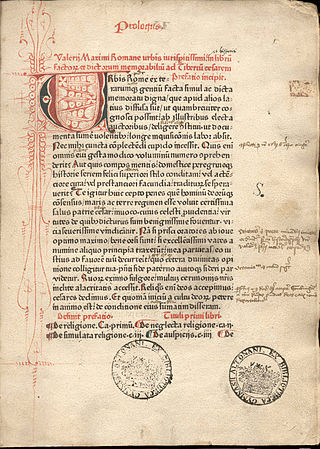
Valerius Maximus was a 1st-century Latin writer and author of a collection of historical anecdotes: Factorum et dictorum memorabilium libri IX. He worked during the reign of Tiberius.

Giles of Rome O.S.A. was a Medieval philosopher and Scholastic theologian and a friar of the Order of St Augustine, who was also appointed to the positions of Prior General of his Order and as Archbishop of Bourges. He is famed as being a logician, producing a commentary on the Organon by Aristotle, and for his authorship of two important works, De Ecclesiastica Potestate, a major text of early 14th century Papalism, and De regimine principum, a guide book for Christian temporal leadership. Giles was styled Doctor Fundatissimus by Pope Benedict XIV.
Gesta Romanorum, meaning Deeds of the Romans, is a Latin collection of anecdotes and tales that was probably compiled about the end of the 13th century or the beginning of the 14th. It still possesses a two-fold literary interest, first as one of the most popular books of the time, and secondly as the source, directly or indirectly, of later literature, in Geoffrey Chaucer, John Gower, Giovanni Boccaccio, Thomas Hoccleve, William Shakespeare, and others.
John Bromyard was an influential English Dominican friar and prolific compiler of preaching aids.
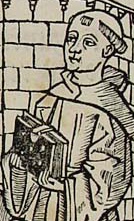
Francesc Eiximenis was a Franciscan Catalan writer who lived in the 14th-century Crown of Aragon. He was possibly one of the more successful medieval Catalan writers since his works were widely read, copied, published and translated. Therefore, it can be said that both in the literary and in the political sphere he had a lot of influence. Among his readers were numbered important people of his time, such as the kings of the Crown of Aragon Peter IV, John I and Martin I, the queen Maria de Luna, and the Pope of Avignon Benedict XIII.
Walter Hilton, Can. Reg. was an English Augustinian mystic, whose works gained influence in 15th-century England and Wales. He has been canonized by the Church of England and by the Episcopal Church in the United States.
The Formicarius, written 1436–1438 by Johannes Nider during the Council of Florence and first printed in 1475, is the second book ever printed to discuss witchcraft. Nider dealt specifically with witchcraft in the fifth section of the book. Unlike his successors, he did not emphasize the idea of the Witches' Sabbath and was skeptical of the claim that witches could fly by night. With over 25 manuscript copies from fifteenth and early sixteenth century editions from the 1470s to 1692, the Formicarius is an important work for the study of the origins of the witch trials in Early Modern Europe, as it sheds light on their earliest phase during the first half of the 15th century.
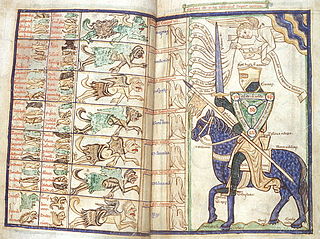
William Perault,, also spelled Perauld; Latinized Peraldus or Peraltus, was a Dominican writer and preacher.

The Speculum Humanae Salvationis or Mirror of Human Salvation was a bestselling anonymous illustrated work of popular theology in the late Middle Ages, part of the genre of encyclopedic speculum literature, in this case concentrating on the medieval theory of typology, whereby the events of the Old Testament prefigured, or foretold, the events of the New Testament. The original version is in rhyming Latin verse, and contains a series of New Testament events each with three Old Testament ones that prefigure it. It is one of the most common books found as an illuminated manuscript, and also in early printing in both blockbook and incunabulum forms.
Thomas of Ireland, also known as Thomas Hibernicus, Thomas Palmeranus, or Thomas Palmerstonuswas an Irish anthologist and indexer.
William of Pagula, also known as William Paull or William Poull, was a 14th-century English canon lawyer and theologian best known for his written works, particularly his manual for priests entitled the Oculus Sacerdotis. Pagula was made the perpetual vicar of the church at Winkfield on 5 March 1314, although he was absent from his parish for several years while pursuing a doctorate in Canon Law from the University of Oxford. After this was granted he returned to work with his parish, and his writings are written from the perspective of someone familiar with the job of a rural priest.

Frithegod, was a poet and clergyman in the mid 10th-century who served Oda of Canterbury, an Archbishop of Canterbury. As a non-native of England, he came to Canterbury and entered Oda's service as a teacher and scholar. After Oda's death he likely returned to the continent. His most influential writing was a poem on the life of Wilfrid, an 8th-century bishop and saint, named Breviloquium Vitae Wilfridi. Several manuscripts of this poem survive, as well as a few other of Frithegod's poems. He was also known for the complexity of his writings, with one historian even calling them "damnably difficult".
Anianusof Celeda was the deacon of a church at a place called Celeda in the early fifth century and a supporter of Pelagius. It is not known where Celeda was: candidates include Pannonia, Northern Italy, Campania, Syria, and Cyrenaica.
William of Luxi, O.P., also Guillelmus de Luxi or, was born in the region of Burgundy, France, sometime during the first quarter of the thirteenth century. He was a Dominican friar who became regent master of Theology at the University of Paris and a noted biblical exegete and preacher.

The Regiment de la Cosa Pública is a work that has 38 chapters and that was written in Catalan by Francesc Eiximenis in 1383. It was just written after Eiximenis' arrival in Valencia, and it was dedicated to the jurats.
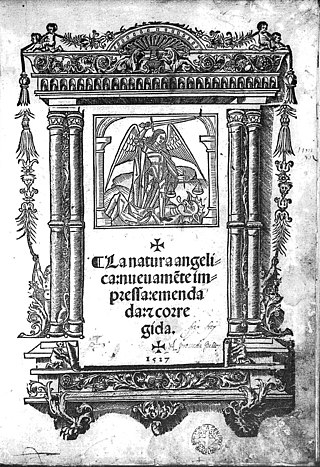
The Llibre dels àngels is a literary work that was written by Francesc Eiximenis in 1392 in Valencia in Catalan. It was dedicated to Pere d'Artés, who was a kind of Chancellor of the Exchequer of the Crown of Aragon, and who was a close friend of him. It has two hundred and one chapters, and it is divided into five treatises.

The Vida de Jesucrist is a literary work by Francesc Eiximenis in Catalan written in Valencia possibly between 1399 and 1406, though the important scholar Albert Hauf dates it to 23 June 1403. It was dedicated to Pere d'Artés, who was a kind of Chancellor of the Exchequer of the Crown of Aragon, whom Eiximenis had already dedicated the Llibre dels àngels.
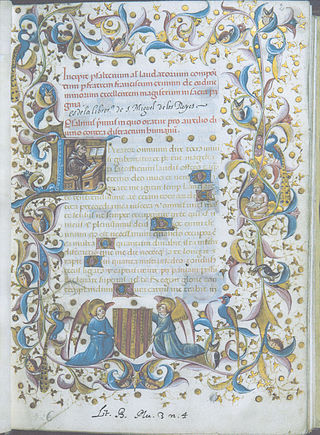
The Psalterium alias laudatorium is a literary work that was written by Francesc Eiximenis in Latin between 1404 and 1408 in Valencia. It consists of a collection of prayers, and was dedicated to the Pope of Avignon Benedict XIII.

The Pastorale (Pastoral) is a literary work that was written by Francesc Eiximenis in Valencia in Latin between 1397 and 1400. It was dedicated to the bishop of Valencia Hug de Llupià.

Scala Dei, also called Tractat de contemplació, is a literary work written by Francesc Eiximenis possibly in 1399 in Valencia in Catalan and dedicated to Maria de Luna, queen of the Crown of Aragon and wife of king Martin of Aragon.
References
Notes
Bibliography
- Diem, Albrecht, ‘A Classicising Friar at Work: John of Wales’ Breviloquium de virtutibus’, in: Alasdair A. MacDonald, Zweder von Martels, and Jan Veenstra (eds.), Christian Humanism: Essays in Honor of Arjo Vanderjagt, Leiden, 2009, pp. 75-102.
- Diem, Albrecht, ‘Virtus est via ad gloriam. John of Wales and Michele da Massa in disagreement’, in: Franciscan Studies 63 (2005), pp. 219-273.
- Kalning, Pamela, ‘Virtues and Exempla in John of Wales and Jacubus de Cessolis’, in István Bejczy and Cary Nederman (eds.), Princely Virtues in the Middle Ages: 1200-1500, Turnhout, 2007.
- Nighman, Chris, ‘Revisiting John of Wales's role in the creation of the Manipulus florum’, in: J. Hamesse, M.-J. Mũnoz Jiménez & C.L. Nighman (eds.), New perspectives on Thomas of Ireland’s Manipulus florum / Nouvelles perspectives sur le Manipulus florum de Thomas d’Irlande, Papers in Mediaeval Studies 32, Toronto: Pontifical Institute of Mediaeval Studies, 2019, pp. 17-30.
- Pantin, William Abel. "John of Wales and Medieval Humanism". John Anthony Watt, John B. Morall and Francis Xavier Martin, eds. Medieval Studies: Presented to Aubrey Gwynn, S.J.. Dublin: 1961, pp. 297–319.
- Swanson, Jenny. John of Wales: A Study of the Works and Ideas of a Thirteenth-Century Friar. Cambridge, 1989.